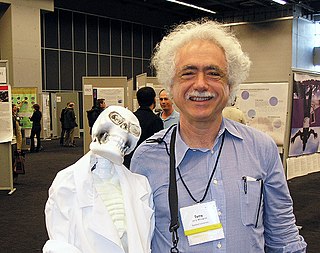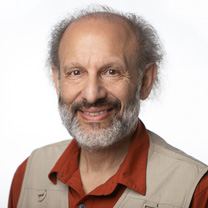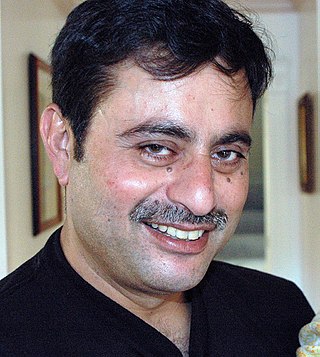
Robert Endre Tarjan is an American computer scientist and mathematician. He is the discoverer of several graph theory algorithms, including his strongly connected components algorithm, and co-inventor of both splay trees and Fibonacci heaps. Tarjan is currently the James S. McDonnell Distinguished University Professor of Computer Science at Princeton University.

Lawrence Edward Page is an American businessman and computer scientist best known for co-founding Google with Sergey Brin.
Alfred Vaino Aho is a Canadian computer scientist best known for his work on programming languages, compilers, and related algorithms, and his textbooks on the art and science of computer programming.

Terry Allen Winograd is an American computer scientist. He is a professor at Stanford University, and co-director of the Stanford Human–Computer Interaction Group. He is known within the philosophy of mind and artificial intelligence fields for his work on natural language using the SHRDLU program.

Vijay Satyanand Pande is a Trinidadian–American scientist and venture capitalist. Pande is best known for orchestrating the distributed computing protein-folding research project known as Folding@home. His research is focused on distributed computing and computer-modelling of microbiology, and on improving computer simulations regarding drug-binding, protein design, and synthetic biomimetic polymers. He is currently a general partner at venture capital firm Andreessen Horowitz.
Social computing is an area of computer science that is concerned with the intersection of social behavior and computational systems. It is based on creating or recreating social conventions and social contexts through the use of software and technology. Thus, blogs, email, instant messaging, social network services, wikis, social bookmarking and other instances of what is often called social software illustrate ideas from social computing.

Mizuko Itō, sometimes known as Mimi Ito, is a Japanese cultural anthropologist and learning scientist. She is Professor in Residence and John D. and Catherine T. MacArthur Chair in Digital Media and Learning, and Director of the Connected Learning Lab in the Department of Informatics, Donald Bren School of Information and Computer Sciences at the University of California, Irvine. Her main professional interest is young people's use of media technology. She has explored the ways in which digital media are changing relationships, identities, and communities.

Mark S. Miller is an American computer scientist. He is known for his work as one of the participants in the 1979 hypertext project known as Project Xanadu; for inventing Miller columns; and the open-source coordinator of the E programming language. He also designed the Caja compiler. Miller is a Senior Research Fellow at the Foresight Institute.
EigenTrust algorithm is a reputation management algorithm for peer-to-peer networks, developed by Sep Kamvar, Mario Schlosser, and Hector Garcia-Molina. The algorithm provides each peer in the network a unique global trust value based on the peer's history of uploads and thus aims to reduce the number of inauthentic files in a P2P network. It has been cited by approximately 3853 other articles according to Google Scholar.
The following outline is provided as an overview of and topical guide to artificial intelligence:
Social search is a behavior of retrieving and searching on a social searching engine that mainly searches user-generated content such as news, videos and images related search queries on social media like Facebook, LinkedIn, Twitter, Instagram and Flickr. It is an enhanced version of web search that combines traditional algorithms. The idea behind social search is that instead of ranking search results purely based on semantic relevance between a query and the results, a social search system also takes into account social relationships between the results and the searcher. The social relationships could be in various forms. For example, in LinkedIn people search engine, the social relationships include social connections between searcher and each result, whether or not they are in the same industries, work for the same companies, belong the same social groups, and go the same schools, etc.

Alex Paul "Sandy" Pentland is an American computer scientist, HAI Fellow at Stanford, Toshiba Professor at MIT, and serial entrepreneur.
Kaltix Corporation was a personalized search engine company founded at Stanford University in June 2003 by Sepandar Kamvar, Taher Haveliwala and Glen Jeh. It was acquired by Google on September 2003.

Rajeev Motwani was an Indian-American professor of computer science at Stanford University whose research focused on theoretical computer science. He was a special advisor to Sequoia Capital. He was a winner of the Gödel Prize in 2001.

Jonathan Jennings Harris is an American artist and computer scientist, known for his work with data visualization, interactive documentary, and ritual.

Andrew Yan-Tak Ng is a British-American computer scientist and technology entrepreneur focusing on machine learning and artificial intelligence (AI). Ng was a cofounder and head of Google Brain and was the former Chief Scientist at Baidu, building the company's Artificial Intelligence Group into a team of several thousand people.
Computational journalism can be defined as the application of computation to the activities of journalism such as information gathering, organization, sensemaking, communication and dissemination of news information, while upholding values of journalism such as accuracy and verifiability. The field draws on technical aspects of computer science including artificial intelligence, content analysis, visualization, personalization and recommender systems as well as aspects of social computing and information science.

A filter bubble or ideological frame is a state of intellectual isolation that can result from personalized searches, recommendation systems, and algorithmic curation. The search results are based on information about the user, such as their location, past click-behavior, and search history. Consequently, users become separated from information that disagrees with their viewpoints, effectively isolating them in their own cultural or ideological bubbles, resulting in a limited and customized view of the world. The choices made by these algorithms are only sometimes transparent. Prime examples include Google Personalized Search results and Facebook's personalized news-stream.
We Feel Fine is an interactive website, artwork, and book created by Jonathan Harris and Sep Kamvar that searches the internet every 10 minutes for expressions of human emotion on blogs and then displays the results in several visually-rich dynamic representations. Created in 2005 and launched in 2006, We Feel Fine was turned into a book in 2009.

Ashish Goel is an American professor whose research focuses on the design, analysis and applications of algorithms. He is a professor of Management Science and Engineering at Stanford University.












